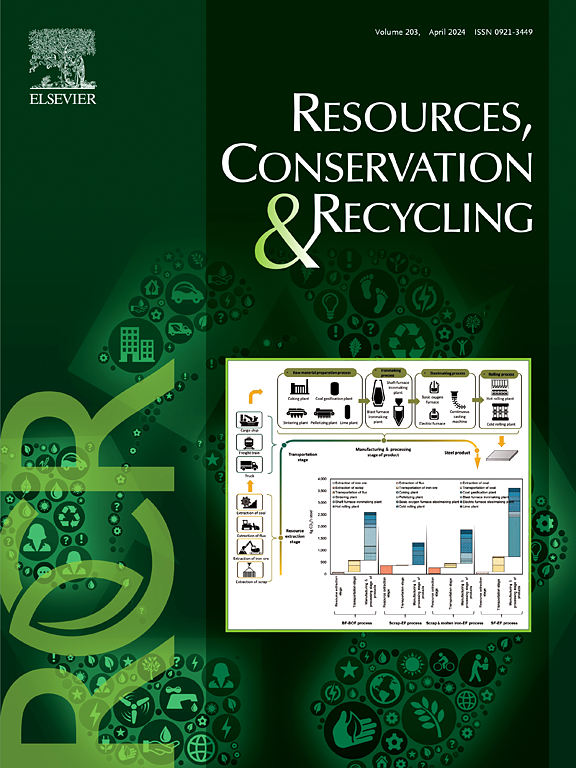中国不同地区食物垃圾成分分析及资源化路径选择
IF 10.9
1区 环境科学与生态学
Q1 ENGINEERING, ENVIRONMENTAL
引用次数: 0
摘要
为了调查中国各地食物浪费的差异,研究了15个不同经济水平和饮食习惯的城市的食物浪费情况。碳氮比(C/N)(11.36 ~ 38.03)和总化学需氧量(TCOD) (29 616 ~ 132 356 mg COD/L)的差异较大,表明不同城市FW的化学特征不同,氨基酸、盐度、辣椒素等指标也存在明显的区域差异。FW从生产到预处理均经过部分水解酸化处理,FW中丰富的原生微生物有利于其循环利用。然而,高盐度和微塑料(MPs)对环境构成了相当大的威胁,直接反映了垃圾分类和塑料控制方面的问题。根据结果和城市概况,提出了特定城市FW增值的资源途径,以生产甲烷、有机酸、酒精、肥料和昆虫蛋白质。本文章由计算机程序翻译,如有差异,请以英文原文为准。

Composition analysis and resource route selection of food waste from different regions of China
To investigate the variation in food waste (FW) across China, waste from 15 cities with different economic levels and dietary habits was investigated. The wide range obtained for the carbon-to-nitrogen (C/N) ratio (11.36 –38.03) and total chemical oxygen demand (TCOD) (29 616 –132 356 mg COD/L) indicates different chemical characteristics for the FW from the different cities, with indices such as amino acids, salinity, and capsaicin also presenting obvious regional differences. FW is partially hydrolyzed and acidified from production to pretreatment, and the abundant indigenous microorganisms in the FW are conducive to its recycling. However, high salinity levels and microplastics (MPs) pose considerable threats to the environment, directly reflecting problems in garbage classification and plastic control. Based on the results and urban profiles, the resource pathways for FW valorization in specific cities are proposed, to enable the production of methane, organic acids, alcohol, fertilizers, and insect proteins.
求助全文
通过发布文献求助,成功后即可免费获取论文全文。
去求助
来源期刊

Resources Conservation and Recycling
环境科学-工程:环境
CiteScore
22.90
自引率
6.10%
发文量
625
审稿时长
23 days
期刊介绍:
The journal Resources, Conservation & Recycling welcomes contributions from research, which consider sustainable management and conservation of resources. The journal prioritizes understanding the transformation processes crucial for transitioning toward more sustainable production and consumption systems. It highlights technological, economic, institutional, and policy aspects related to specific resource management practices such as conservation, recycling, and resource substitution, as well as broader strategies like improving resource productivity and restructuring production and consumption patterns.
Contributions may address regional, national, or international scales and can range from individual resources or technologies to entire sectors or systems. Authors are encouraged to explore scientific and methodological issues alongside practical, environmental, and economic implications. However, manuscripts focusing solely on laboratory experiments without discussing their broader implications will not be considered for publication in the journal.
 求助内容:
求助内容: 应助结果提醒方式:
应助结果提醒方式:


